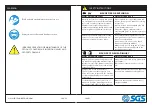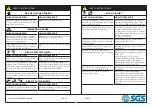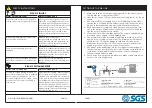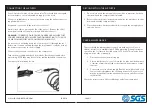
PAGE 5
PAGE 4
RISK OF LOSS OF HEARING
WHAT COULD HAPPEN
HOW TO PREVENT IT
Long term exposure to noise produced
from the operation of air tools can lead to
permanent hearing loss.
Always wear hearing protection.
INHALATION HAZARD
WHAT COULD HAPPEN
HOW TO PREVENT IT
Abrasive tools such as grinders, sanders
and cut-off tools generate dust and abra-
sive materials which can be harmful to the
lungs and respiratory system.
Always wear a properly fitting facemask or
respirator when using such tools.
Some materials such as adhesives and tar
contain chemicals whose vapours could
cause serious injury with exposure.
Always work in a clean, dry, well-ventilated
area.
RISK OF ELECTRIC SHOCK
WHAT COULD HAPPEN
HOW TO PREVENT IT
Using air tools to attach electrical wiring
can result in electrocution or death.
Never use nail/staplers to attach electrical
wiring while energized
This tool is not provided with an insulated
gripping surface. Contact with a “live”
wire will also make exposed metal parts of
the tool “live” and can result in electrocu-
tion.
Avoid body contact with grounded sur-
faces such as pipes, radiators and refriger-
ators. There is an increased risk of electric
shock if your body is grounded.
Fasteners coming in contact with hidden
electrical wiring could cause electrocution
or death.
Thoroughly investigate the work piece for
possible hidden wiring before performing
work.
RISK OF CUT OR BURNS
WHAT COULD HAPPEN
HOW TO PREVENT IT
Tools that cut, shear, drill, staple, punch &
chisel are capable of causing serious injury.
Keep the working part of the tool away
from hands and body.
SAFETY INSTRUCTIONS
RISK OF INJURY
WHAT COULD HAPPEN
HOW TO PREVENT IT
A tool left unattended or with the air hose
attached can be activated by unauthorized
persons leading to injury.
Remove air hose when tool is not in use
and store tool in secure location away
from reach of children and untrained users.
Air tools can inadvertently propel fasten-
ers or other materials in work area.
Use only parts, fasteners and accessories
recommended by SGS Engineering.
Keep work area clean and free of clutter.
Keep children and others away from tool
while it is in operation.
Keep work area well lit.
A wrench or a key that is left attached to a
rotating part of the tool increases the risk
of personal injury.
Remove adjusting keys and wrenches
before turning the tool on.
Using inflator nozzles for duster applica-
tions can cause serious injury.
DO NOT use inflator nozzles for duster
applications.
Air tools can become activated by acci-
dent during maintenance or tool changes.
Remove air hose to lubricate or add grind-
ing attachments, sanding discs, drills, etc.
to the tool.
Never carry the tool by the hose.
Avoid unintentional starting. Don’t carry
the tool with a finger on the trigger.
Only an authorised service representative
should perform repair servicing.
Air tools can cause the work piece to
move upon contact, leading to injury.
Use clamps or other devices to prevent
movement.
Loss of control of the tool can lead to
injury to self or others.
Never use tool while using drugs or
alcohol. Don’t over-reach. Keep proper
footing and balance. Keep handles dry,
clean and free from oil/grease. Stay alert.
Watch what you are doing. Use common
sense. Do not operate the tool when you
are tired.
SAFETY INSTRUCTIONS
WWW.SGS-ENGINEERING.COM


























